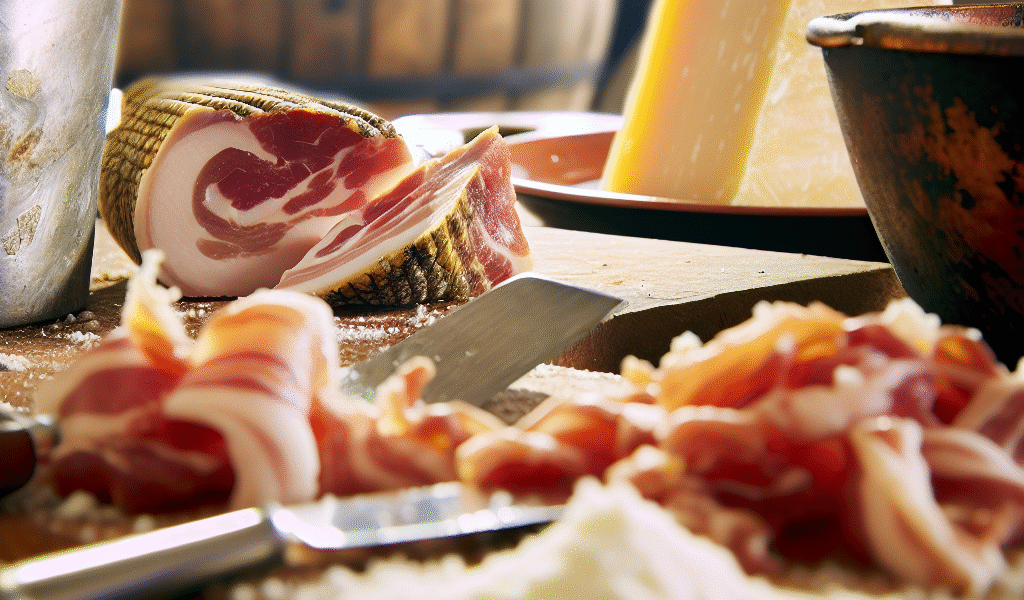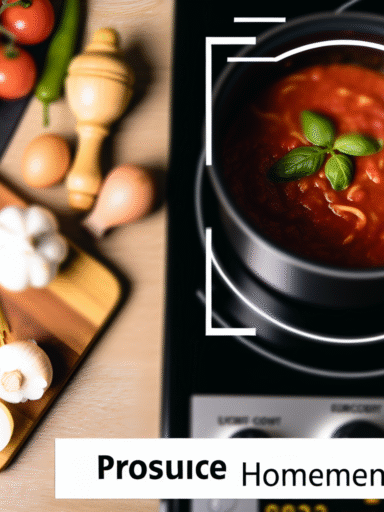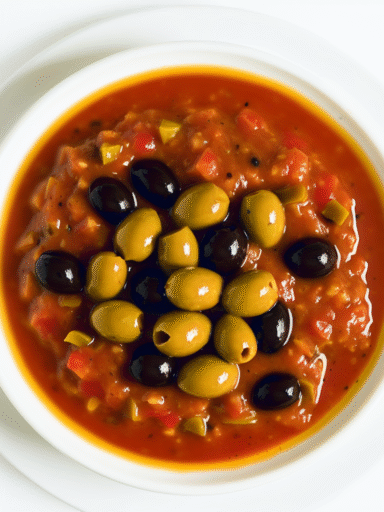Amatriciana
Amatriciana is a classic Italian sauce bursting with bold flavors and rustic charm. Originating from the town of Amatrice in the Lazio region, this tomato-based sauce combines savory cured pork, tangy tomatoes, and a touch of heat for a perfect pasta pairing that’s simple yet unforgettable. Whether you’re whipping it up for a weeknight dinner or impressing guests, Amatriciana delivers a hearty, comforting punch every time.
Tags / Categories
- Flavor Profile: Savory, spicy, tangy
- Main Ingredients: Guanciale (pork cheek), tomatoes, pecorino cheese, chili flakes
- Region: Lazio, Italy
- Usage: Pasta sauce (traditionally for bucatini), topping for polenta
Quick Info Box
- Prep Time: 10 minutes
- Cook Time: 25 minutes
- Total Time: 35 minutes
- Difficulty Level: Easy to Medium
- Yield: Serves 4
Ingredients List
- 150g guanciale, diced (substitute pancetta if unavailable)
- 400g canned San Marzano tomatoes, crushed
- 1 small red chili or 1 tsp red chili flakes (adjust to taste)
- 50g Pecorino Romano cheese, finely grated
- 2 tbsp extra virgin olive oil
- 1 small onion (optional), finely chopped
- Salt, to taste
- Freshly cracked black pepper, to taste
- 400g bucatini or spaghetti pasta
Instructions
- Sear the guanciale. Heat olive oil in a large skillet over medium heat. Add the diced guanciale and cook until it’s golden and crispy, releasing its delicious fat — about 5-7 minutes. Stir occasionally and don’t rush; that fat is where the magic happens.
- Add aromatics and chili. For a slightly sweeter depth, toss in the finely chopped onion and cook until translucent, about 3-4 minutes. Then stir in your chili flakes or fresh chili to let the heat infuse the fat. Your kitchen will start smelling amazing right about now!
- Introduce the tomatoes. Pour in the crushed San Marzano tomatoes. Lower the heat to a gentle simmer, stirring occasionally. Let the sauce cook down and thicken, usually around 15 minutes. If it gets a little chunky, don’t stress — that’s rustic charm.
- Season the sauce. Taste your sauce and add salt sparingly; guanciale and Pecorino are salty already. A few cracks of black pepper add a lovely peppery touch here.
- Cook the pasta. Meanwhile, bring a large pot of salted water to a boil. Cook your bucatini or spaghetti until al dente, according to package directions.
- Combine pasta and sauce. Drain the pasta, reserving a cup of the pasta water. Toss the pasta with the sauce in the skillet over low heat. If it seems dry, add a splash of pasta water to marry everything beautifully.
- Finish with Pecorino. Remove from heat and stir in most of the Pecorino Romano cheese, reserving a bit for serving. This will add that signature tangy, creamy punch.
Serving Suggestions
- Serve immediately with an extra sprinkle of Pecorino Romano and a drizzle of good olive oil.
- Classic pairing: Serve with bucatini pasta, twirling those long tubes around your fork for maximum sauce delight.
- Great over polenta for a comforting twist on the traditional.
- For a modern plate, add freshly chopped parsley or basil for brightness.
Origin & History
Amatriciana traces back to the small town of Amatrice, nestled in Italy’s Lazio region. Originally, it was a simple shepherd’s sauce made from cured pork cheek (guanciale) and local tomatoes introduced from the New World. Pecorino Romano cheese, made from sheep’s milk in nearby pastures, rounds out the flavors. Over the centuries, Amatriciana has become a symbol of Roman culinary pride, beloved for its simplicity and punch. Fun fact: the recipe was codified only in the 1960s, yet its roots are much older, dating back to at least the 18th century.
Variations & Substitutions
- Guanciale substitute: Pancetta or thick-cut unsmoked bacon work well in a pinch, though authentic flavor favors guanciale.
- Dietary modifications: For a vegetarian version, skip the meat and sauté mushrooms and smoked paprika for that umami kick.
- Tomato options: Fresh ripe tomatoes can be used in summer; just peel and crush them before cooking.
- Heat level: Adjust chili flakes or fresh chili according to your spice tolerance — it’s supposed to have a gentle warmth, not overpower.
Storage & Make-Ahead Tips
If you’d like to make it ahead, cool the sauce completely before transferring it to an airtight container. Store in the refrigerator for up to 3 days or freeze for up to 2 months. When reheating, gently warm it on the stove with a splash of water or pasta water to loosen it up — avoid overheating to preserve that fresh tomato brightness.
Nutritional Information (per serving)
- Calories: ~450 kcal
- Protein: 18g
- Fat: 18g
- Carbohydrates: 50g
- Fiber: 3g
- Sodium: Moderate (depending on guanciale and cheese amount)
Related Sauces / Try Next
- Carbonara – Another Roman classic featuring eggs, Pecorino, guanciale, and black pepper.
- Puttanesca – A punchy sauce with olives, capers, anchovies, and tomatoes.
- Cacio e Pepe – Simplicity at its best with cheese and pepper on pasta.
FAQ
- Can I use bacon instead of guanciale?
- Yes, though bacon lacks the same rich, porky flavor and fat content of guanciale. Pancetta is closer if you can find it.
- What pasta is best for Amatriciana?
- Bucatini is traditional because its hollow shape catches the sauce beautifully, but spaghetti or rigatoni work great too.
- Is Amatriciana always spicy?
- It has a gentle spicy kick from the chili, but you can adjust or omit chili flakes to suit your taste.
Amatriciana is a wonderful example of how a few simple, quality ingredients can transform into a deeply satisfying sauce. With its rich, savory guanciale, tangy tomatoes, and salty Pecorino cheese, it’s no surprise this dish has stolen hearts worldwide. Try making it tonight—your kitchen will thank you!



